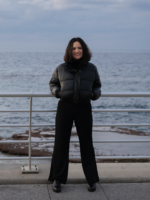Poem of the Week | February 16, 2015
Katherine Smith: "Milk"
This week we offer another poem from our new winter issue, 37.4. Katherine Smith’s poems have appeared in a number of journals, among them The Cincinnati Review, Ploughshares, Mezzo Cammin, Unsplendid, Measure, Gargoyle, The Journal of the Motherhood Initiative, Shenandoah, The Southern Review, Atlanta Review, and Appalachian Heritage. Her first book, Argument by Design (Washington Writers’ Publishing House), appeared in 2003. Her second book of poetry, Woman Alone on the Mountain, appeared with Iris Press in Fall 2014. She teaches at Montgomery College in Maryland where she is Poetry Editor for the Potomac Review.
Author’s note:
“Milk” was the result of my curiosity about the worried expression on Rembrandt’s face in his self-portrait and an attempt to find a language for that anxiety.
When I visit the National Gallery in DC, I often visit Rembrandt’s self-portrait. The face is so kind, so worried (this is a classic male expression to my mind). Rembrandt lived large. He loved luxury, was a spendthrift and bankrupt who lost a fortune buying exotic objects that inspired him. He also flooded the market with his paintings and the paintings of his pupils, for a time devaluing their currency. He made many mistakes. A lot of them were financial, others romantic. Romantic and financial mistakes are the very stuff of ordinary life. Maybe because I’ve become over time and after many mistakes of my own, a cautious person, mistakes interest me.
Not all losses are the result of bad choice: Rembrandt lost three of his four children before losing his young wife to tuberculosis, a disease carried by milk. She gave birth to their son Titus while ill with tuberculosis and shortly after died. I imagine her breasts still full of milk even as she died of a milk-born illness. I imagine Saskia’s husband Rembrandt van Rijn trying to hold onto the good fortune with which he began life through the material treasures that surround him: his son, his son’s wet nurse and her milky breasts. Finally through drawing trees I imagine the artist’s coming as close as possible to an evanescent and perhaps illusory grace.
“Truth has no currency,” writes poet Tomas Tranströmer. I think there are people for whom this isn’t quite true. Objects can help some people hold on, for a long while. Rembrandt came from a culture that adored material goods: furniture, shells, tiles, copper pots and pans, rich silks. The sixteenth century Dutch made a fetish out of porcelain and oak, satin and emeralds. In the end though, I imagine the artist looking—as who hasn’t in the face of tragedy?—for something “real” to hold onto and finding nothing, other than the grace of his talent, the sun , and milk.
Milk
Rembrandt van Rijn
SEE THE ISSUE
SUGGESTED CONTENT

Poem of the Week
Apr 22 2024
“Faith” by Nur Turkmani
“Faith” by Nur Turkmani is our Poem of the Week. Nur Turkmani lives in Beirut and researches social movements, gender, displacement, and agriculture. Her writing appears in West Branch, The… read more

Poem of the Week
Apr 15 2024
“Love Poem for Lois” by Regan Green
“Love Poem for Lois” by Regan Green is our Poem of the Week. Regan Green grew up in Columbia, Tennessee, and now lives in Baltimore. She is a junior lecturer… read more

Poem of the Week
Apr 08 2024
“Gray” by Melissa Ginsburg
“Gray” by Melissa Ginsburg is our Poem of the Week. Melissa Ginsburg is the author of the poetry collections Doll Apollo (winner of the Mississippi Institute of Arts and Letters… read more

